
Friday, June 27 and Saturday, June 28, 2014
FADOGRAPH OF A YESTERN SCENE
(1971)
Samuel Barber (1910-1981)
Barber’s
Fadograph of a Yestern Scene
is scored for piccolo,
two flutes, two oboes, English horn, two clarinets, bass
clarinet, two bassoons, four horns, three trumpets, three
trombones, tuba, timpani, percussion, harp, piano, celesta
and strings. The performance time is 7 minutes. This is the
first performance of this work by the Grant Park Orchestra.
Fadograph of a Yestern Scene
originated in a commission from the Alcoa
Foundation for the 1971 inauguration of Heinz Hall as the new home of the
Pittsburgh Symphony Orchestra in the renovated Loew’s Penn Theatre; William
Steinberg conducted the work’s premiere on September 11, 1971. The title
comes from the opening scene of James Joyce’s
Finnegans Wake
, in which the
newly deceased’s body is laid out between barrels of beer and whiskey as the
centerpiece for an inebriated leave-taking from his friends: “
Grampupus is fallen
down
but grinny sprids the boord. Whase on the joint of a desh? Fin-
foefom
the Fush. Whase be his baken head? A loaf of Singpan
try’s Kennedy bread. And
whase hitched to the hop in his tayle?
A glass of Danu U’Dunnell’s foamous
olde Dobbelin ayle. But,
lo, as you would quaffoff his fraudstuff and sink teeth
through
that pyth of a flowerwhite bodey behold of him as behemoth for
he
is noewhemoe. Finiche! Only a fadograph of a yestern scene.
Almost rubicund
Salmosalar, ancient fromout the ages of the Agapemonides, he is smolten in our
mist, woebecanned and packt
away
.”
It is unknown if Barber settled on the quote from Joyce’s famously ambiguous
text as the work’s title before he began
Fadograph of a Yestern Scene
or if he
added it later, but the phrase is an appropriate match for the work’s autumnal
mood of longing for things past — “fadograph,” perhaps, suggests a faded
photograph; “yestern” is an archaic form of “yesternight,” the nocturnal
equivalent of “yesterday.” The music is dark in color, hushed in dynamics, and
steadily pulsing rather than strongly marked in rhythm, rising in expressive
intensity only for a short passage near the center. “A quiet, impressionistic
work,” wrote Allen Hughes in his review of the premiere for
The New York Times
,
“that might have come from a musical era long since passed.”


